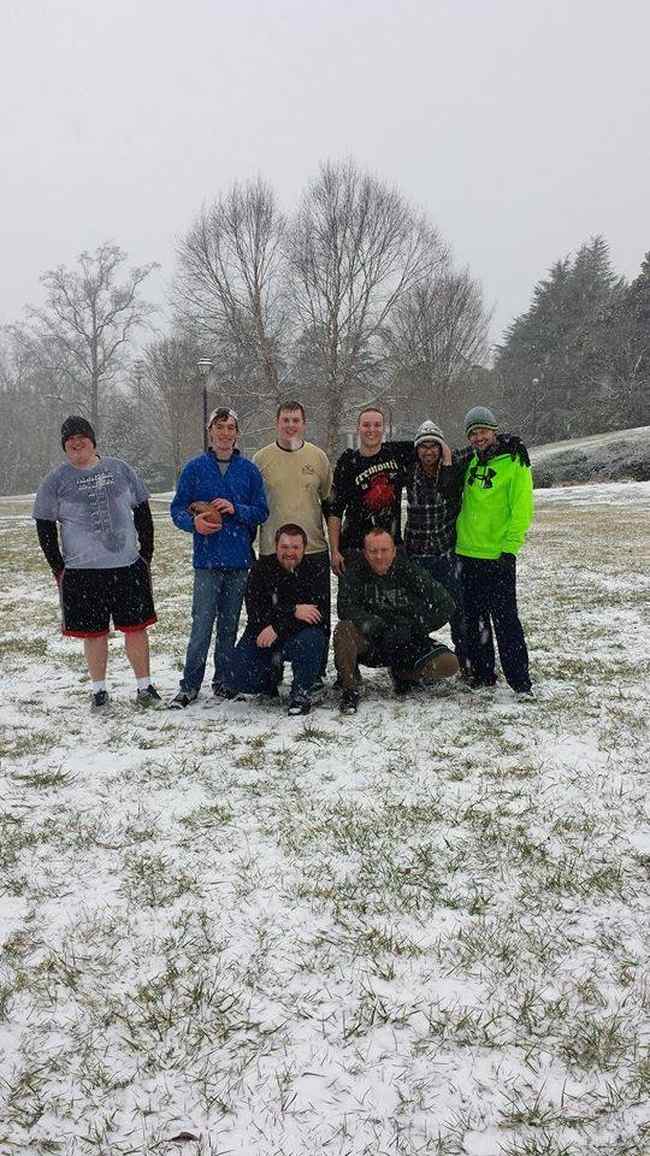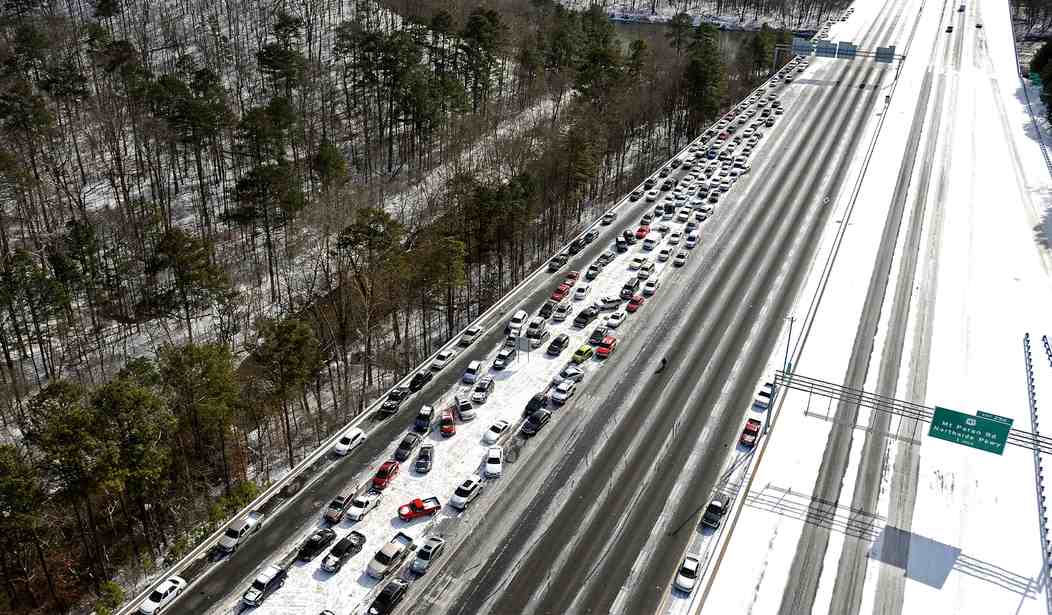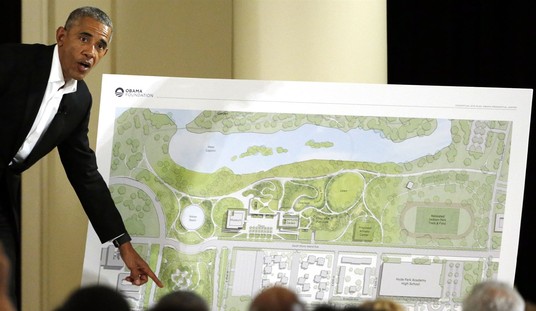Wintertime in the South can be crazy. For example, last Saturday, temperatures got down into the teens here in Georgia, but by Thursday, we were back in the 60s and even had a few thunderstorms come through. Significant snowstorms are a rarity in places like metro Atlanta, so they tend to leave an impression on us Southerners.
I’ve written before about some of those storms that wreaked havoc on metro Atlanta. Two years ago, I wrote about the 40th anniversary of “Snow Jam,” a major storm that brought the metro area to a standstill, and last year, I wrote about the Blizzard of ’93, a storm that shut north Georgia down for several days the week before the first day of spring.
Ten years ago today, a different kind of snowstorm plagued Atlanta, and it’s the kind of tale that legends are made of. But this isn’t one of those “Southerners can’t drive in the snow” stories; rather, it’s a cautionary tale about urban sprawl, the failure of businesses, municipalities, and school systems to coordinate with each other, and one local official who thought he was better than anybody else.
For starters, let me give you an explanation of how poorly designed Atlanta’s interstates are. Three interstates converge in downtown Atlanta: I-20, which moves west to east through the heart of the city, I-75, which goes northwest to southeast, and I-85, which travels northeast to southwest.
In the 1950s, before Atlanta got too big, some brilliant engineers decided to merge I-75 and I-85 into one road for 7.4 miles through midtown and downtown Atlanta. The project took 12 years, and nobody ever wonderded whether it was a bad idea. There’s also I-285, a perimeter ring around Atlanta’s urban core, and the traffic on it is terrible even when the weather is perfect.
The debacle that we’ve come to call “Snowpocalypse” began on Sunday, Jan. 26, 2014. The National Weather Service issued a Winter Storm Watch for the northern and central parts of Georgia for Tuesday morning, Jan. 28. Meteorologists continued to issue watches and advisories throughout the day on Monday, but the timing kept changing.
Terminology digression: "Snowpocalypse" and "Snowmageddon" are often interchangeable when describing this fateful couple of days. Some reporters at the Atlanta Journal-Constitution (AJC) tried to dub it “Storm Jam,” but it didn’t take. Other people liked "SnOMG," but that doesn't translate as well in the written word as it does out loud.
On the morning of “Snowpocalypse,” I was at a Chamber of Commerce event in Rockdale County, one county over from where I lived and worked (and still do). I was the office manager for an IT managed services provider at the time, and as my outside sales rep and I walked to his car, we both looked up and said, “What do you know? It’s snowing.” But we didn’t think much of it.
By the time we got back to the office, the owner of the company said we needed to close the office and head home. I was lucky; my commute was one left turn out of the parking lot and a straight shot about eight miles home. People who worked in Atlanta weren’t so fortunate.
Most snowstorms in metro Atlanta take place overnight; growing up, it was a tradition to wake up to snow on the ground and turn on the news to see if the school system was out for the day. Significant snowfall starting in the middle of the workday is a rarity, which was another complication of this storm.
The trouble began when businesses, school systems, and government offices all sent employees and students home at the same time. While it’s difficult to coordinate thousands of privately owned businesses, the school systems and government offices could easily have let people go home earlier. That terribly planned interstate system in metro Atlanta was stretched to its limits.
“So on Tuesday, as schools, businesses, and governments, announced plans to close early, everyone who works in Atlanta headed for the freeways to get home or collect their children,” Rebecca Burns explained in a post-mortem of the storm in Politico, adding, “We’re not morons, Northerners: The problem was not one of Southerners’ inability to drive on icy roads but of too many cars headed for congested highways.”
(For what it’s worth, that paragraph is the truest statement Burns made in the whole piece. She tried to blame the problems from the storm on “white flight” at one point and insisted that metro Atlantans are too selfish to want a transit system ruining the suburbs, thus leading to "Snowpocalypse.")
Flashback: Remembering Snow Jam: the Storm That Paralyzed Atlanta 40 Years Ago This Week
The traffic map from that day will blow your mind:
On the 7th anniversary of “Snowpocalypse,” the AJC related some of the stats from the impact of the storm:
1,200: Traffic accidents were reported, according to CBS News
5: Hours after the first snowfall that Gov. Nathan Deal declared a state of emergency
6: Hours it could take to drive 10 miles. For those heading from downtown to the burbs, it was even worse. [Nobody in Atlanta calls it “the burbs.” —CQ]
2.6: Inches of snow that fell, according to CNN meteorologist Chad Myers
18: Hours before traffic returned to normal
Over 500: Cars one wrecking service said it towed following the storm
At least $10 million: Value of the property losses, including damaged cars and burst pipes
Those are staggering numbers, but the stories are more fascinating. Drivers who were used to 30-minute commutes stayed on the road for hours. People ran out of gas and had no choice but to leave their cars on the side of the road — or in the road. (The tendency of some people to run their cars close to empty was an exacerbating factor that doesn't get mentioned as often as it should.)
School administrators who realized that they couldn’t get their students out safely bunked kids down for the night as some frantic parents made their way to schools to pick up their children. Some employees spent the night at their workplaces. The gridlock lasted into Wednesday.
Atlanta Mayor Kasim Reed got himself into some controversy during the worst of the storm. Reed, whom most non-Democrats and many Democrats despised, demonstrated an astonishing level of arrogance. The AJC reported:
Hours before Reed would stand at a press conference with Gov. Nathan Deal to address a winter storm crisis, the mayor and a handful of staffers used emergency lanes to cruise their way to an interview with The Weather Channel, located just off the heart of the worst congestion — I-75 and I-285.
In vehicles driven by sworn police officers, they bypassed thousands of drivers after 5 p.m. in what quickly became one of the most notorious weather-induced, man-made gridlocks in Atlanta’s history. Some motorists were stranded on stretches of the interstate days after Winter Storm Leon virtually shut down the metro area.
Reed justified his behavior by talking to reporters after the danger was over.
Whizzing around stranded motorists with a police escort “gave me an amplifying capability to help people stay safe,” he told the Atlanta Press Club. Appearing on the Weather Channel was important for the corrupt mayor because he needed to tell people to stay off the roads. “I thought people needed to hear that from me.” Thanks, Kasim.
Flashback: Remembering the 'Storm of the Century': 30 Years Ago Today
My cousin Rob, who penned his account for his company’s newsletter, told me the story of seeing the weather that was coming and leaving work somewhat before the mass exodus. When Rob told his boss he was leaving, his boss could only reply, "But... the spreadsheets?" Rob dodged some of the worst traffic and made it home safe and sound — just in time to lose power for a few hours.
My sister-in-law Kelly wasn’t as lucky. She worked in an office on the northeast corner of I-285 at the time (her employer has since allowed her to work from home), and she left work only to find herself in the maelstrom of “Snowpocalypse” traffic.
“I remember taking a picture of the temp in my car and it was 9 degrees,” she said. “Very few cars were on the road, but closer to Atlanta there were lots of tractor-trailers pulled along the side of the road, just stopped with their trucks running and some not running, and then in some areas the tractor-trailers were just stopped in the middle of the road.”
Kelly said she drove for 10 hours to get home as the rest of our family prayed for her safety. Her drive home was complicated by the fact that off-ramps were closed. At one point, she saw a man handing out bottles of water to stranded motorists.
“Nice new cars slid all sorts of directions but were just abandoned in the middle of the road,” she recalled. “I was able to get off at the exit past my work exit, and gas stations and everything were even closed. But I was able to find one Waffle House open to go to the bathroom. Ice was everywhere! It really looked like an atomic bomb or something had struck the area, and everyone just ran. Salt trucks were even abandoned in the middle of the road.”
My cousin Jason had to spend the night in his work truck because the northbound gridlock on I-75 was so bad. Temperatures in his truck got so cold that his phone screen shattered.
My friend Sam was in school at Piedmont College (now Piedmont University) in the northeastern part of the state. He was far from the craziness in Atlanta, but he said that campus police took the kayak he had atop his Jeep and put it in storage because they feared someone would steal it to try to use it as a sled.
Sam recalled playing football in the snow with guys he still maintains friendships with. The school would cancel classes one day at a time because the roads would thaw and refreeze, so he spent nine days at school with no classes.

“We had no idea what was going on off campus at the time,” Sam recalled. “Later in the afternoon, someone got on social media long enough to read that Atlanta was completely gridlocked. I don't remember exactly what was said, but the sentiment was something to the effect of ‘that's another good reason to be up here in God's country.’"
Flashback: The Better (Snow) Angels Of Our Nature
Some encouraging stories came out of “Snowpocalypse.” I mentioned the man Kelly saw passing out bottles of water on the interstate, and consumer expert Clark Howard, who was a Georgia National Guard reservist at the time, rode out with other reservists to help stranded commuters.
Atlantans stocked up on groceries and handed them out to motorists. At least one Good Samaritan delivered a baby on the side of the road, and Chick-fil-A franchisees made sandwiches for those stuck on their ride home. The Facebook page “Snowed Out ATL” debuted during the storm, and it helped Atlantans in subsequent winter weather events at least through 2017.
When all was said and done, “Snowpocalypse” was the result of faulty urban planning decades before the event and poor responses from local and state authorities during the storm. Supposedly, the city and state have learned from their mistakes, but I guess we’ll find out the next time a snow event rolls around.










Join the conversation as a VIP Member